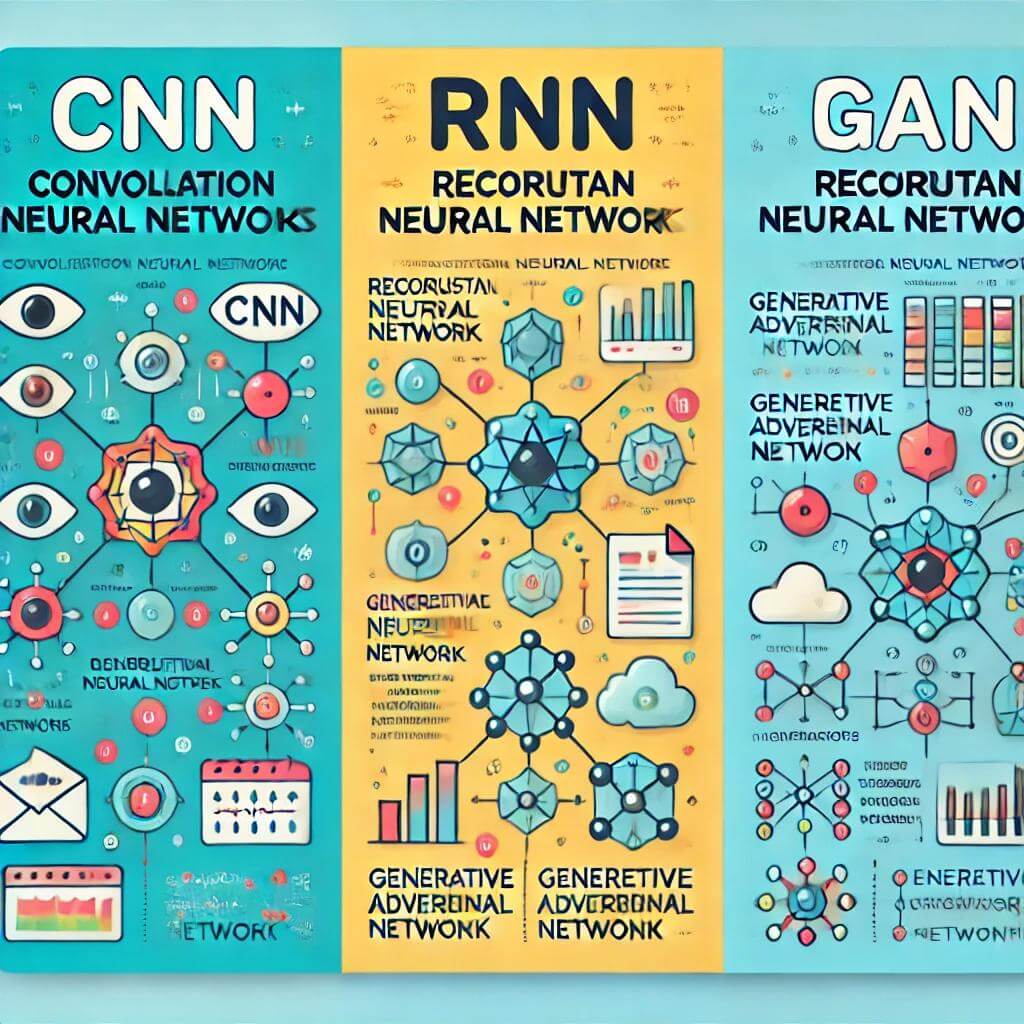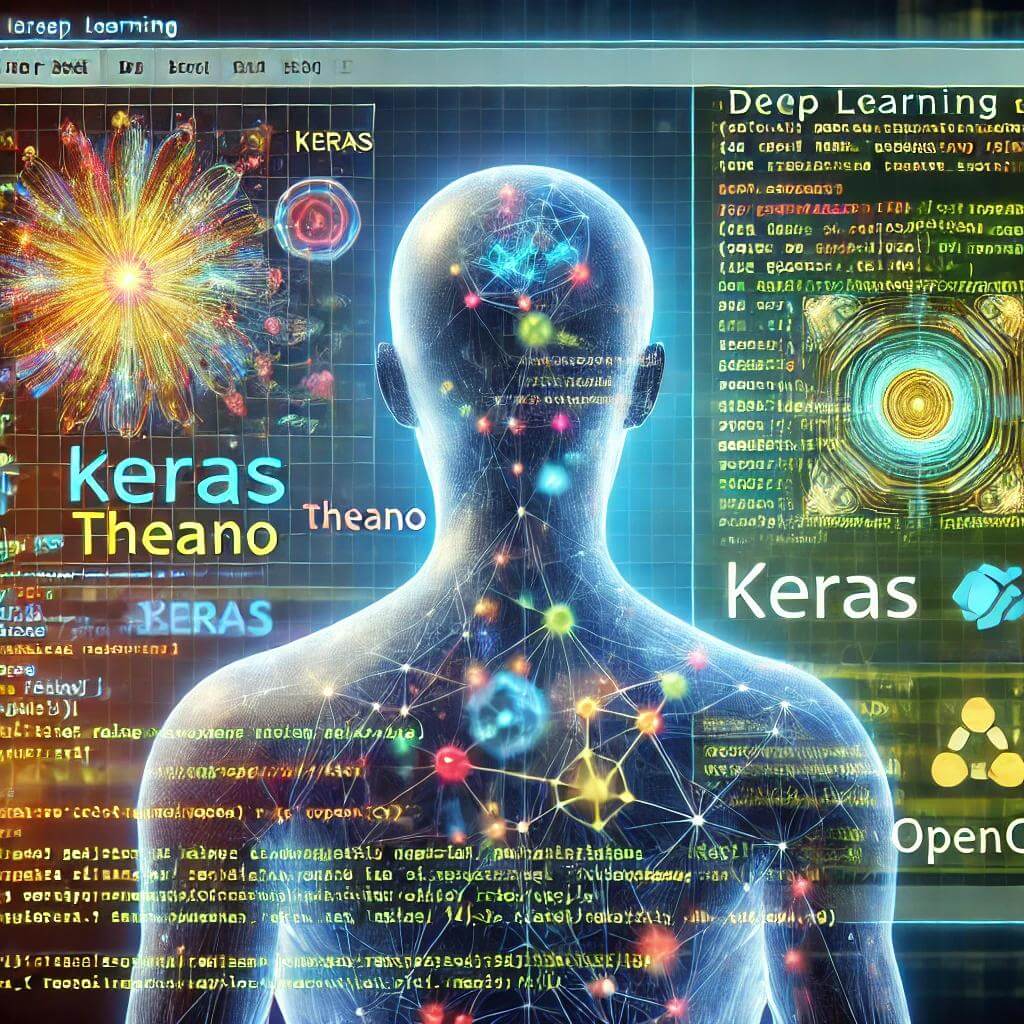Understanding CNN, RNN, and GAN Neural Networks
Neural networks come in different types, each designed for specific tasks. While the concept of a neural network is inspired by the human brain, various architectures have been developed to tackle distinct problems. Let’s explore the most popular types of neural networks: CNN, RNN, and GAN, and see how they work.
Convolutional Neural Networks (CNN)
Convolutional Neural Networks, or CNNs, are specialized in processing structured grid-like data, most commonly images. They are widely used in image recognition and computer vision tasks.
How CNN Works
CNNs use layers called convolutional layers that apply filters to detect patterns in the data, like edges, textures, or shapes. These filters move across the image, looking for specific patterns in small regions of the input data. Once a pattern is detected, the CNN moves to the next region, continuing this process until the entire image has been scanned.
Key Components of CNN
- Convolutional Layers: Extract features by applying filters.
- Pooling Layers: Reduce the spatial dimensions of the data, making the computation more efficient.
- Fully Connected Layers: After extracting features, the data is passed to these layers for classification.
# Example of creating a simple CNN using Python (Keras)
from keras.models import Sequential
from keras.layers import Conv2D, MaxPooling2D, Flatten, Dense
model = Sequential()
model.add(Conv2D(32, kernel_size=(3, 3), activation='relu', input_shape=(28, 28, 1)))
model.add(MaxPooling2D(pool_size=(2, 2)))
model.add(Flatten())
model.add(Dense(128, activation='relu'))
model.add(Dense(10, activation='softmax'))
model.compile(optimizer='adam', loss='categorical_crossentropy', metrics=['accuracy'])
Applications of CNN
- Image Classification: Labeling objects within images (e.g., identifying cats, dogs).
- Object Detection: Locating and identifying multiple objects within an image.
- Medical Imaging: Analyzing MRI scans, X-rays, and CT scans to detect anomalies.
| Component | Function |
|---|---|
| Convolutional Layer | Extracts features from input data |
| Pooling Layer | Reduces spatial dimensions |
| Fully Connected Layer | Final classification layer |
Recurrent Neural Networks (RNN)
Recurrent Neural Networks, or RNNs, are designed to handle sequential data, where the current input depends on the previous inputs. They have the unique ability to remember previous information, making them perfect for tasks like language modeling and time-series forecasting.
How RNN Works
RNNs maintain a hidden state that updates with each new input. This allows them to pass information from one time step to the next. Unlike traditional neural networks, which treat each input independently, RNNs use this memory to understand the relationships between inputs over time.
Types of RNNs
- Simple RNN: The basic RNN architecture that processes sequences of data.
- LSTM (Long Short-Term Memory): A more advanced form of RNN designed to remember long-term dependencies and avoid the vanishing gradient problem.
- GRU (Gated Recurrent Units): A simpler alternative to LSTM, which uses fewer parameters but still maintains effective memory.
# Example of creating an RNN using Keras
from keras.models import Sequential
from keras.layers import SimpleRNN, Dense
model = Sequential()
model.add(SimpleRNN(100, input_shape=(10, 1)))
model.add(Dense(1))
model.compile(optimizer=’adam’, loss=’mean_squared_error’)
Applications of RNN
- Natural Language Processing (NLP): Tasks like text generation, language translation, and speech recognition.
- Time-Series Forecasting: Predicting stock prices, weather, or sales trends based on historical data.
- Chatbots: Understanding and responding to sequential text input in real time.
Generative Adversarial Networks (GAN)
Generative Adversarial Networks (GANs) represent a breakthrough in the field of generative models. GANs are unique in that they consist of two competing networks: a generator and a discriminator.
How GAN Works
- Generator: The generator network’s job is to create fake data that looks real. It tries to fool the discriminator by generating data that’s indistinguishable from the real data.
- Discriminator: The discriminator’s job is to classify whether the data it receives is real (from the actual dataset) or fake (from the generator). As the two networks compete, they both improve, resulting in the generator producing highly realistic data.
# Example of creating a simple GAN using Keras
from keras.models import Sequential
from keras.layers import Dense
import numpy as np
# Generator
generator = Sequential()
generator.add(Dense(128, input_dim=100, activation='relu'))
generator.add(Dense(784, activation='sigmoid'))
# Discriminator
discriminator = Sequential()
discriminator.add(Dense(128, input_dim=784, activation='relu'))
discriminator.add(Dense(1, activation='sigmoid'))
discriminator.compile(optimizer='adam', loss='binary_crossentropy')
Applications of GAN
# Example of creating a simple GAN using Keras
from keras.models import Sequential
from keras.layers import Dense
import numpy as np
# Generator
generator = Sequential()
generator.add(Dense(128, input_dim=100, activation='relu'))
generator.add(Dense(784, activation='sigmoid'))
# Discriminator
discriminator = Sequential()
discriminator.add(Dense(128, input_dim=784, activation='relu'))
discriminator.add(Dense(1, activation='sigmoid'))
discriminator.compile(optimizer='adam', loss='binary_crossentropy')
- Image Generation: GANs are used to generate realistic images, such as creating new human faces or enhancing image resolution.
- Art and Creativity: GANs are used to generate unique artwork, music, and even new video game levels.
- Data Augmentation: GANs can generate synthetic data to help train machine learning models, especially when real data is limited.
Comparing CNN, RNN, and GAN
Each of these neural networks serves a distinct purpose and shines in different domains.
| Network Type | Ideal Use Cases | Key Strengths |
|---|---|---|
| CNN | Image-related tasks | Excels at feature extraction from images |
| RNN | Sequential data (text, time-series) | Remembers previous inputs |
| GAN | Generating new data (images, music) | Powerful generative abilities |
Conclusion
Neural networks like CNN, RNN, and GAN have revolutionized their respective fields by handling data in new and powerful ways. CNNs dominate in tasks involving images, RNNs excel in understanding sequences, and GANs open new possibilities in creative and generative tasks. Each network type has its strengths and weaknesses, making them suitable for different types of problems.




Post Comment